Growing up, my grandmother’s kitchen was full of life. It was like stepping into Puerto Rico itself. The sizzling, the smells, and the memories made it more than food. It was a celebration of our culture and family.
Puerto Rican food is a journey through history. It mixes Spanish, African, and Taíno flavors in a unique way. It’s bold, fresh, and tells a story with every bite.
This guide will show you three tasty Puerto Rican lunch recipes. They capture the spirit of island cooking. Whether you’re a pro in the kitchen or just starting, these recipes will bring a bit of Puerto Rico to your home.
Table of Contents
Discover more delicious recipes and ideas by visiting our homepage!
Understanding Puerto Rican Culinary Heritage
Puerto Rican cuisine is a vibrant mix of cultures. It tells a story of Spanish, African, and Taíno influences. These traditions blend together in unique dishes.
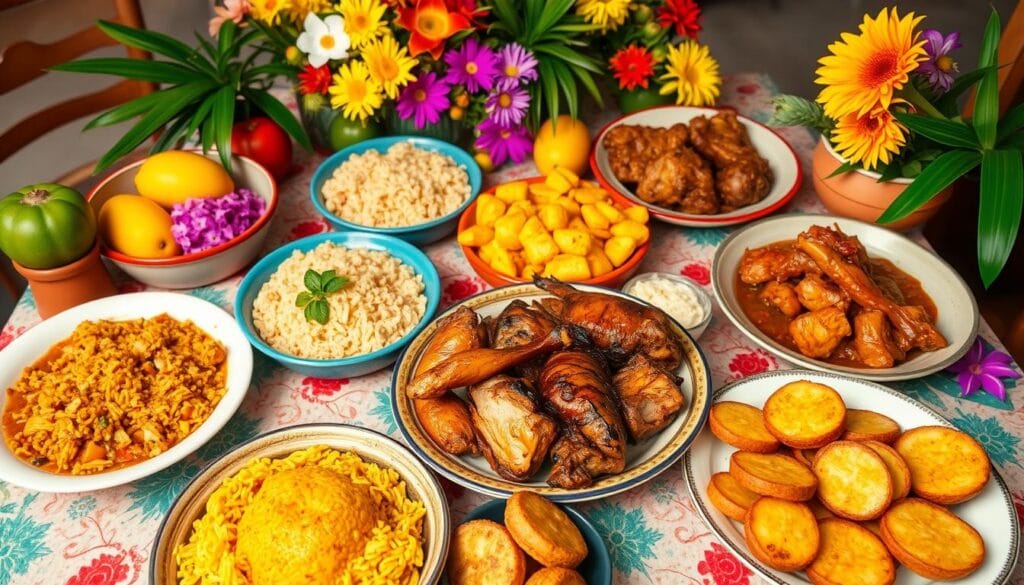
The history of Puerto Rican cooking is complex. Each culture added its own flavors and methods. This mix transformed traditional dishes.
Origins of Puerto Rican Cooking
Puerto Rican cuisine started with a mix of traditions. The Taíno people introduced ingredients like:
- Cassava
- Corn
- Pineapple
- Sweet potatoes
Key Cultural Influences
The top 5 foods in Puerto Rico show the island’s cultural roots:
| Culture | Culinary Contribution |
|---|---|
| Spanish | Rice, olive oil, bacalaítos |
| African | Cooking techniques, plantains, okra |
| Taíno | Root vegetables, grilling methods |
Traditional Cooking Methods
Puerto Rican cooking uses special techniques. These methods give its dishes a unique taste:
- Sofrito preparation
- Slow-cooking stews
- Deep-frying techniques
- Open-fire roasting
Knowing these cooking roots helps us understand Puerto Rican food. It shows how the culture has evolved while keeping its heritage alive.
Essential Puerto Rican Seasonings and Ingredients
Puerto Rican cuisine is full of vibrant flavors. These come from a mix of seasonings and ingredients. Knowing these key elements helps you make dishes that truly capture the island’s spirit.
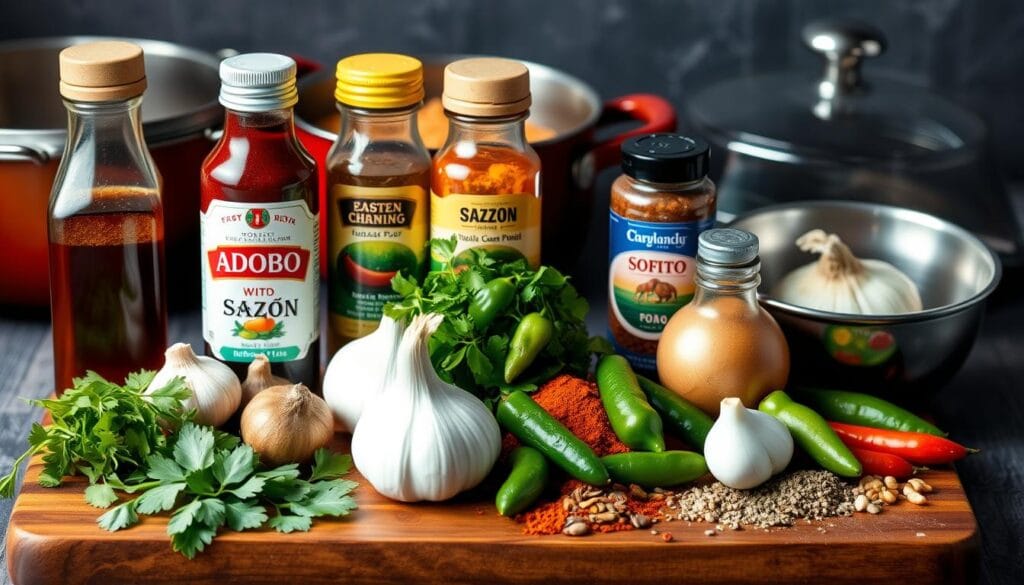
The heart of Puerto Rican cooking is its unique seasonings. Sofrito, a mix of herbs and aromatics, is the base for many dishes. There are three main seasonings that make meals special:
- Sofrito: A green sauce made from herbs and vegetables
- Adobo: A dry seasoning blend with salt, pepper, and spices
- Sazón: A colorful seasoning that adds depth and color to dishes
Looking into common side dishes in Puerto Rico, you’ll find many staple ingredients. Root vegetables and legumes are key in Puerto Rican cooking:
| Ingredient | Culinary Use | Nutritional Benefit |
|---|---|---|
| Plantains | Fried as tostones or mashed | High in potassium and fiber |
| Yuca | Boiled or fried side dish | Rich in carbohydrates |
| Beans | Mixed in rice or served separately | Excellent protein source |
These ingredients and seasonings are more than just food. They celebrate Puerto Rican culture. Each one tells a story of the island’s rich traditions, blending Spanish, African, and Taíno influences.
The Art of Making Sofrito From Scratch
Sofrito is a key ingredient in Puerto Rican cooking, adding authentic flavor to many dishes. It’s a mix of herbs and vegetables that turns simple ingredients into amazing meals.
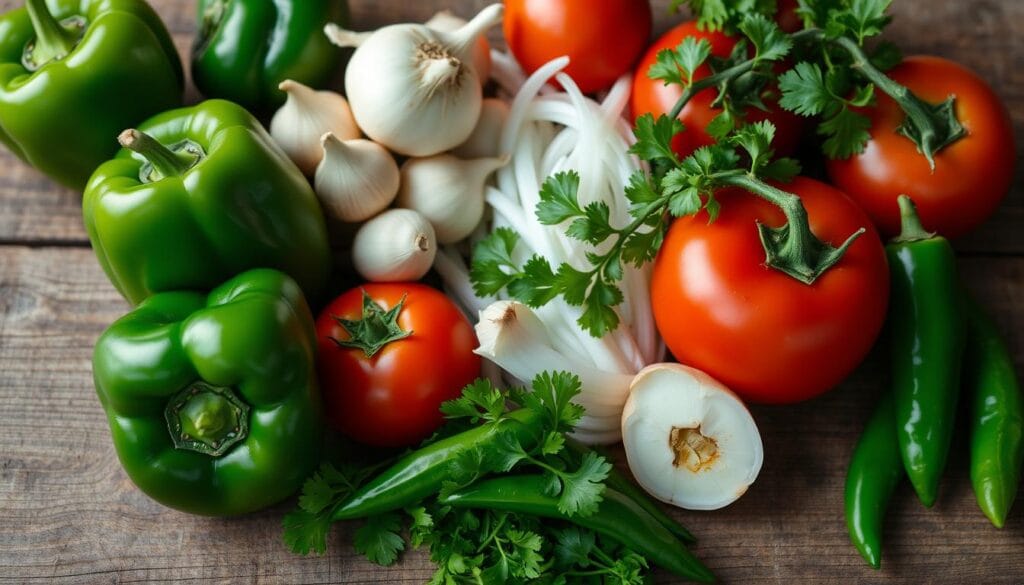
Fresh Ingredients Selection
Starting with fresh ingredients is key to making great sofrito. You’ll need:
- Fresh cilantro
- Ripe green peppers
- Sweet onions
- Garlic cloves
- Culantro (optional but traditional)
Preparation Steps
Here’s how to make your sofrito:
- Wash all vegetables thoroughly
- Remove stems and seeds from peppers
- Roughly chop ingredients
- Blend in a food processor until smooth
- Achieve a consistent, fine texture
Storage Tips
| Storage Method | Duration | Best Practices |
|---|---|---|
| Refrigerator | 1 week | Store in airtight glass container |
| Freezer | 3-4 months | Freeze in small portion containers |
Pro tip: Freeze sofrito in ice cube trays for easy portioning. Each cube is a perfect serving size for quick meals.
Popular Puerto Rican Lunch Recipes
Exploring Puerto Rican meals reveals a world full of flavors and traditions. The island’s cuisine offers delicious lunch options that highlight its rich heritage.
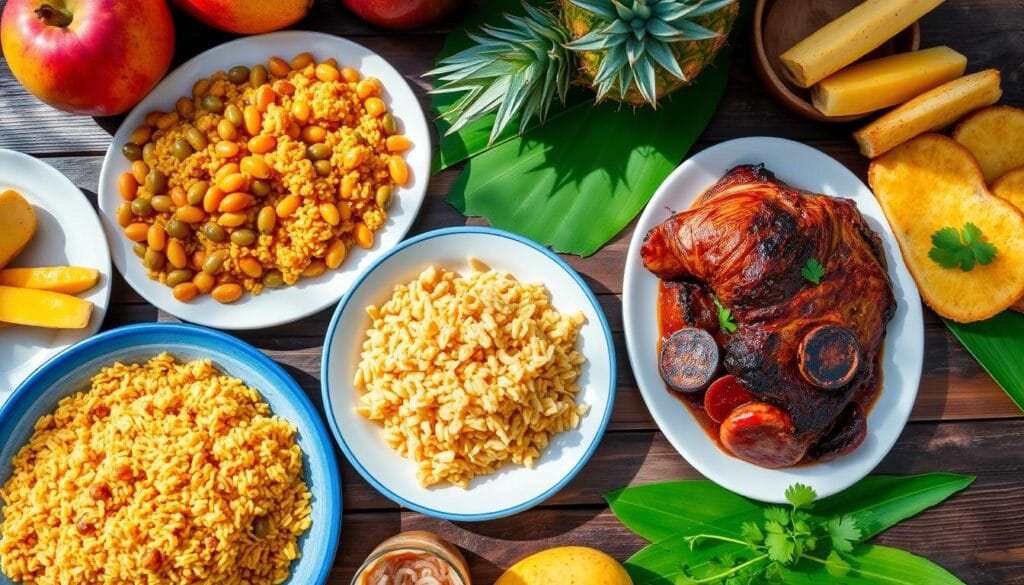
- Arroz con Gandules: The national dish of Puerto Rico
- Mofongo: A plantain-based delicacy
- Pollo Guisado: A hearty chicken stew
Arroz con gandules is more than a meal; it’s a cultural icon. This rice and pigeon peas dish is a perfect mix of flavors that define Puerto Rican cooking. Each dish has its own story, blending Spanish, African, and Taíno traditions.
| Dish | Key Ingredients | Cultural Significance |
|---|---|---|
| Arroz con Gandules | Rice, Pigeon Peas, Sofrito | National Dish, Festive Staple |
| Mofongo | Green Plantains, Garlic, Pork Cracklings | Versatile Main Course |
| Pollo Guisado | Chicken, Vegetables, Spices | Comfort Food Classic |
These dishes do more than fill your belly; they connect families through food. Each recipe offers a mix of nutrients, including veggies, proteins, and carbs, for a healthy meal.
Mastering Arroz con Gandules
Arroz con gandules is a beloved Puerto Rican dish. It combines rich flavors with cultural heritage. This dish is more than a meal; it’s a journey through Puerto Rican tradition.
When making arroz con gandules, choosing the right ingredients is key. The quality of your ingredients will affect the dish’s taste.
Selecting Your Ingredients
The base of a great arroz con gandules starts with the right ingredients:
- Medium-grain rice (preferably long-grain Puerto Rican style)
- Fresh pigeon peas (gandules)
- Sofrito sauce
- Olive oil
- Seasonings like cumin, oregano, and salt
Cooking Techniques
Cooking arroz con gandules needs patience and precision. Begin by sautéing sofrito in olive oil. Then, add rice and pigeon peas. Stir well to coat everything evenly and prevent sticking.
Serving Suggestions
Pair arroz con gandules with these common Puerto Rican sides:
- Roasted pork (pernil)
- Tostones (fried plantains)
- Avocado salad
- Roasted chicken
The secret to perfect arroz con gandules is to honor traditional cooking while adding your own twist.
Creating Authentic Mofongo
Mofongo is a key dish in Puerto Rican food, among the top 5 in Puerto Rico. It turns simple ingredients into a masterpiece that shows the island’s rich food culture.
To make real mofongo, you need a few important ingredients. First, pick the right green plantains – usually four large ones for a classic dish.
- Core Ingredients:
- 4 green plantains
- 4 cloves of garlic, minced
- 1 cup chicharrón (crispy pork cracklings)
- ½ cup chicken or vegetable broth
Frying the plantains is key. Cook them for 5-7 minutes until they’re golden and crispy. The goal is to get them just right – crispy on the outside, soft on the inside.
| Preparation Step | Technique |
|---|---|
| Plantain Preparation | Peel and slice green plantains |
| Frying | Deep fry until golden (5-7 minutes) |
| Mashing | Combine with garlic and chicharrón |
| Serving | Shape into balls, serve with broth |
Mofongo is very flexible. Vegetarians can use sautéed mushrooms instead of chicharrón. Meat lovers might add garlic shrimp or stewed beef. It’s often served with arroz con gandules for a full Puerto Rican meal.
Whether you love cooking or just want to try Puerto Rican food, mofongo is a great choice. Every bite is a taste of tradition, creativity, and amazing flavors.
Perfecting Pollo Guisado
Pollo guisado is a key dish in Puerto Rican cuisine. It’s a chicken stew filled with rich flavors. It’s a must-have in a traditional Puerto Rican meal.
Exploring Puerto Rican cooking means learning to make dishes like pollo guisado. It turns simple ingredients into unforgettable meals.
Meat Preparation Essentials
Here’s how to prep chicken for pollo guisado:
- Choose bone-in chicken for the best taste
- Wash chicken in cold water
- Pat dry with paper towels
- Cut chicken into equal pieces for even cooking
Seasoning Balance
Getting the right flavors is key. Here’s how to season:
| Seasoning | Purpose | Quantity |
|---|---|---|
| Adobo | Main seasoning | 2 tablespoons |
| Sofrito | Base flavor | 1/4 cup |
| Oregano | Herbal taste | 1 teaspoon |
Cooking Process
Follow these steps for a true Puerto Rican dish:
- Marinate chicken for 30 minutes
- Brown chicken in hot oil
- Add sofrito and veggies
- Simmer for 45 minutes
- Check chicken is 165°F inside
Your pollo guisado will take you to Puerto Rico’s kitchens. It’s a real taste of authentic dining.
Side Dishes and Accompaniments
In Puerto Rico, side dishes add a burst of flavor to any meal. Tostones and alcapurrias are favorites that bring amazing taste and texture. They’re key to making any lunch special.
Let’s explore the top side dishes in Puerto Rico:
- Tostones: Crispy fried plantains that are smashed and double-fried to golden perfection
- Alcapurrias: Savory fritters made from green banana masa and filled with seasoned meat
- Rice and beans (arroz con gandules)
- Boiled green bananas
- Salad with avocado
Tostones are loved for their crunchy outside and soft inside. They’re a salty, crunchy side that goes well with main dishes. Alcapurrias have a rich flavor, with green banana coating and seasoned meat filling.
When making these dishes, pay attention to texture and seasoning. A bit of adobo or garlic can make them truly special.
Pro tip: Serve your side dishes right after cooking. This keeps them hot and crispy. They usually take 20-30 minutes to make and serve 4-6 people as a great addition to your meal.
Tips for Recipe Success
Mastering Puerto Rican lunch recipes needs focus and the right steps. Whether it’s arroz con gandules or mofongo, knowing key cooking techniques boosts your skills.
Common Mistakes to Avoid
When cooking Puerto Rican lunch recipes, common mistakes can ruin the dish. Here are key errors to avoid:
- Overcooking rice, which can make it mushy and lose its texture
- Using unripe plantains in mofongo
- Skipping the sofrito base in traditional recipes
- Not allowing enough marinating time for meats
Kitchen Equipment Essentials
Having the right tools is vital for authentic Puerto Rican lunch recipes. Invest in these essential items:
| Equipment | Purpose | Recommended Type |
|---|---|---|
| Caldero | Traditional rice cooking | Cast aluminum or heavy-bottom pot |
| Pilón | Mashing ingredients | Wooden mortar and pestle |
| Sharp Chef’s Knife | Precise ingredient preparation | 8-inch stainless steel |
Time Management Strategies
Being efficient is key to making great Puerto Rican lunch recipes. Mise en place – getting ingredients ready before cooking – saves time and reduces stress. Here are some tips:
- Prep ingredients the night before
- Marinate meats in advance
- Make sofrito in bulk and freeze
- Clean as you cook to minimize post-meal cleanup
By following these tips, you’ll make delicious Puerto Rican lunch recipes with confidence and authenticity.
Health Benefits and Nutritional Value
Puerto Rican food is not just tasty; it’s also very healthy. When you look at the top 5 foods in Puerto Rico, you find many ingredients that are good for you. These foods help keep you healthy and well.
Traditional Puerto Rican dishes use foods that are full of nutrients. These foods offer great health benefits. Let’s look at some of the key ingredients:
- Plantains: High in fiber, vitamin C, vitamin B6, and potassium
- Beans: Excellent source of protein and heart-healthy nutrients
- Yuca: Rich in fiber, potassium, and vitamin C
- Avocados: Packed with heart-healthy fats and antioxidants
- Root Vegetables: Support metabolic health and glucose regulation
Research shows the health benefits of these foods. A 2022 study found that root vegetables help with metabolic health. They improve glucose and lipid levels. Beans are a great source of protein without the bad fats, which is good for your cholesterol.
| Ingredient | Key Nutritional Benefits | Health Impact |
|---|---|---|
| Plantains | Fiber, Vitamin C, Potassium | Supports Immune and Gut Health |
| Beans | Protein, Fiber, Iron | Heart Health, Cholesterol Management |
| Avocados | Healthy Fats, Antioxidants | Cardiovascular Disease Prevention |
By choosing these healthy ingredients, you can enjoy tasty Puerto Rican dishes. These meals are not just good for you; they’re also delicious. The mix of fresh veggies, lean proteins, and whole foods makes Puerto Rican food a true nutritional treasure.
Meal Planning and Preparation
Mastering puerto rican lunch recipes needs good planning and smart prep. When you look into typical puerto rican meals, you find they often have many parts. These parts can be made ahead of time.
Here are some key strategies for meal planning:
- Batch cooking rice and beans on weekends
- Preparing sofrito in large quantities
- Marinating proteins like chicken 24 hours ahead
- Chopping vegetables in advance
A balanced puerto rican lunch usually has:
- Protein (like pollo guisado)
- Rice and beans
- Plantains
- Small salad or vegetable side
Time-saving tips can make you create comida criolla fast. Think about making adobo seasoning and sofrito on weekends. These can be kept in the fridge for quick meals during the week.
For busy people, meal prepping puerto rican lunch recipes can change your cooking. Spend a few hours on weekends to prep. Then, enjoy tasty, homemade meals all week.
Conclusion
Your journey through Puerto Rican lunch recipes shows a vibrant culinary world. These dishes are more than food; they celebrate culture and family. From arroz con gandules to pollo guisado, each recipe shares a story of love and connection.
Puerto Rican cuisine is full of flavors, not just in main dishes. You’ve seen lunch recipes, but also try appetizers like tembleque and drinks like piña colada. These add to the island’s rich food experience.
Cooking is an art of love and creativity. Every dish you make connects you to your heritage. Try new ingredients and techniques, adding your own flair. The kitchen is your canvas, with Puerto Rican cuisine as your guide.
Your culinary adventure is just starting. Keep exploring, tasting, and sharing these recipes. Puerto Rican cuisine is a journey of discovery, inviting you to enjoy every bite and make memories at the table.
FAQ
What are the most popular lunch dishes in Puerto Rican cuisine?
In Puerto Rico, lunch favorites include Arroz con Gandules (rice with pigeon peas) and Mofongo (mashed fried plantains). Pollo Guisado (chicken stew) and Lechón Asado (roasted pork) are also loved. These dishes mix Spanish, African, and Taíno flavors, showing Puerto Rico’s rich food culture.
What ingredients are essential in Puerto Rican cooking?
Key to Puerto Rican cooking are sofrito, plantains, rice, beans, and adobo seasoning. Garlic, onions, and meats like chicken and pork are also important. These ingredients create deep flavors and are nutritious.
What are some popular Puerto Rican appetizers?
Alcapurrias (green banana fritters) and Tostones (fried plantain slices) are favorites. They’re crispy and flavorful, making them great snacks or side dishes.
How is sofrito made in traditional Puerto Rican cooking?
Sofrito is made by finely chopping cilantro, onions, garlic, peppers, and sometimes tomatoes. This base adds a key flavor to many dishes. It can be stored in the fridge for later use.
What are common side dishes in Puerto Rican meals?
Tostones, Arroz Blanco, Habichuelas, Ensalada, and Aguacate are common sides. They add variety and nutrition to meals, showing the island’s diverse flavors.
What makes Puerto Rican cuisine unique?
Puerto Rican food is special because of its mix of Spanish, African, and Taíno flavors. Techniques like slow-cooking and using adobo and sazón give it a unique taste. Local ingredients and traditional methods also make it stand out.
Are there any traditional Puerto Rican desserts?
Yes, Tembleque (coconut pudding) and Flan are beloved desserts. The island is also famous for the Piña Colada, a global cocktail that started in Puerto Rico.
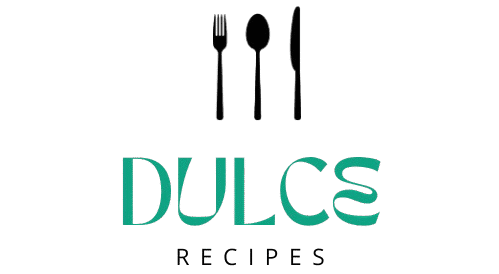

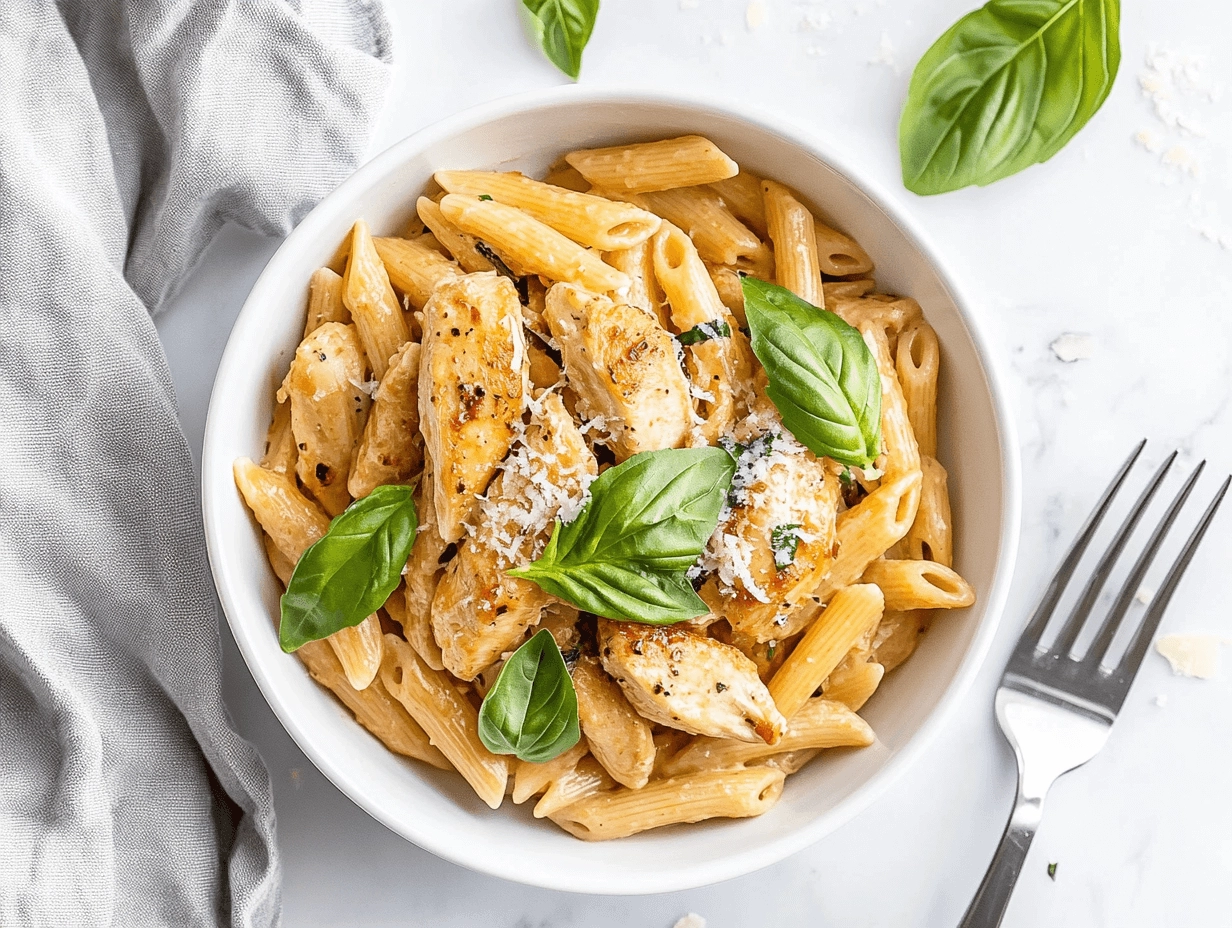
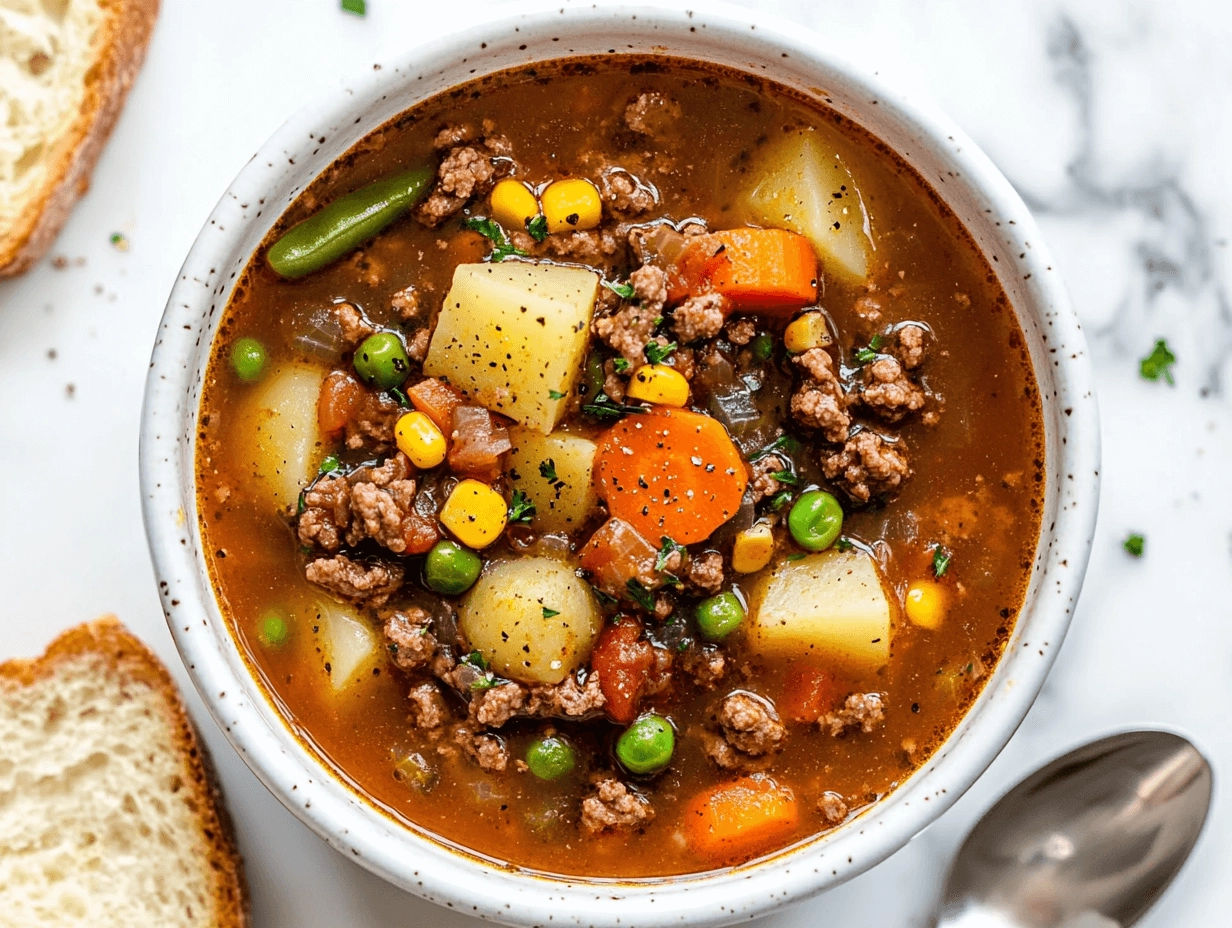
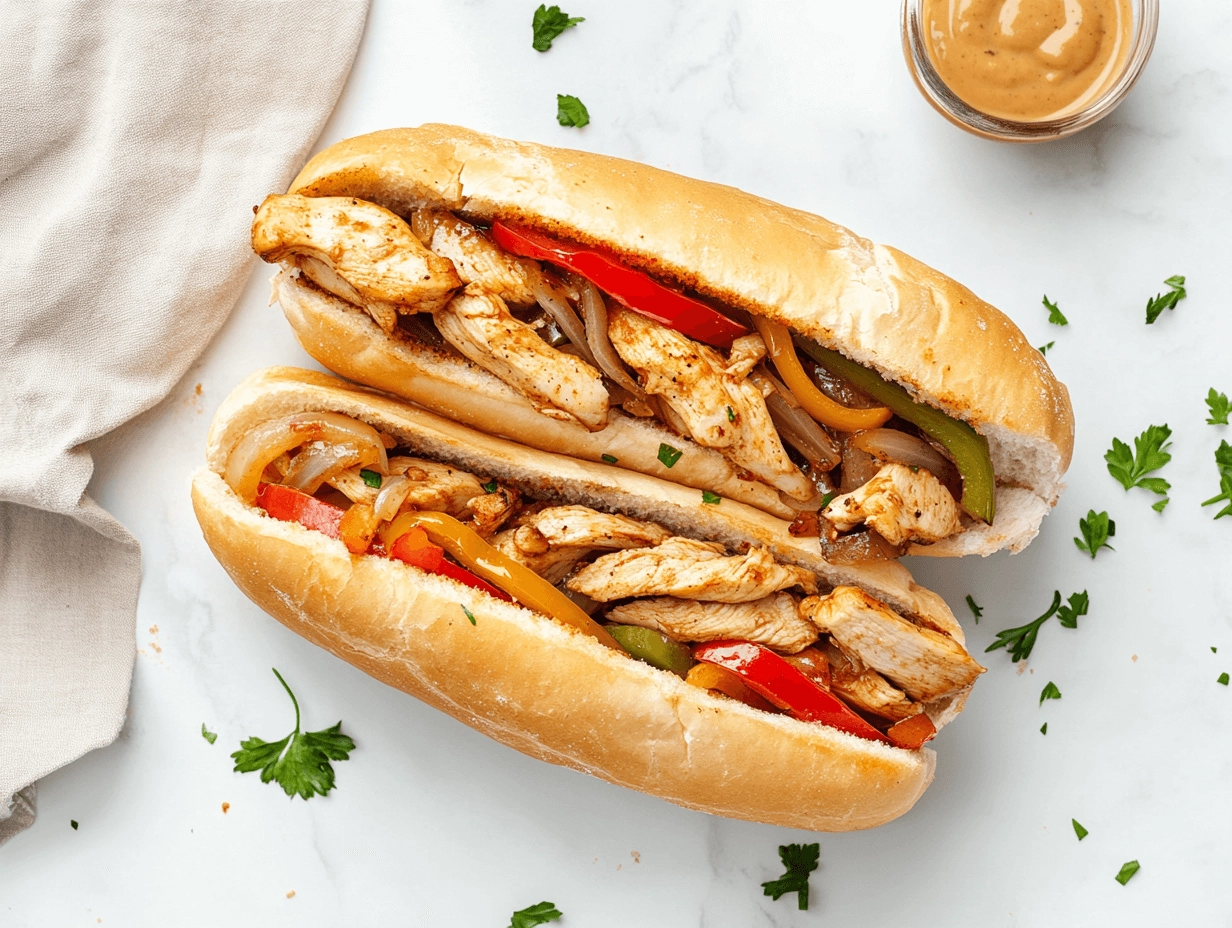

1 thought on “3 Delicious Puerto Rican Lunch Recipes to Try”